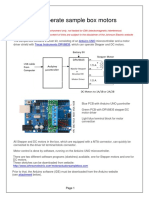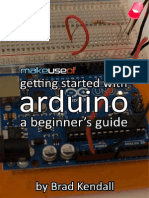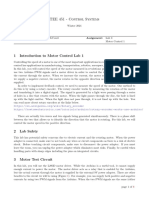Arduino Motor Shield
Arduino Motor Shield
Uploaded by
digital media technologiesCopyright:
Available Formats
Arduino Motor Shield
Arduino Motor Shield
Uploaded by
digital media technologiesCopyright
Available Formats
Share this document
Did you find this document useful?
Is this content inappropriate?
Copyright:
Available Formats
Arduino Motor Shield
Arduino Motor Shield
Uploaded by
digital media technologiesCopyright:
Available Formats
handson.dmt.fh-joanneum.
at
ARDUINO
Workpackage: Description: Arduino UNO Motor Shield This workpackage deals with the Motor shield for Arduino. The motor shield is designed for controlling inductive loads, like magnets, motors and relays. As a result you should be able to connect a 4-wire bipolar stepper motor to the Arduino motor shield and create a waving-machine. advanced - Introduction o DC Motor o Stepper Motor - Instructions o Build a waving machine o Write the program o Flash the program - Troubleshooting - Useful Resource Hardware: - Arduino UNO - Motor Shield - 4 wire bipolar stepper motor Software: - Arduino Studio
Difficulty (1-10): Overview:
Requirements:
Carelse, Pauger, Pilz
Instructions
handson.dmt.fh-joanneum.at
INTRODUCTION
This work package deals with connecting a motor to the Arduino Uno. For powering inductive loads a special design is necessary. Furthermore, most motors need more power than the Arduino can provide. The motor shield is capable of powering two DC at the same time or one bipolar stepper motor. The maximum voltage is 12 V, the maximum current is 2A or 4A when externally supplied.
DC Motor
A direct current, or DC motor, is commonly used motor, powered by a battery or external direct current power supply. It is a popular and strong motor with high rotations per minute. But you just can adjust the speed and the direction, it is not possible to drive the motor to exact positions.
Stepper Motor
A stepper motor is also powered by direct current, but its design is completely different. Instead of having one pair of coils it is driven by numerous coils, all of them are powered separately. This enables exact positioning. If you are not familiar, you should read the introduction about all the different motors and available.
Instructions
Attach the motor shield on top of the Arduino.
Build a waving machine
You can see several connectors on top of the motor shield. For connecting the stepper motor we use the blue screw terminal. You will notice that the stepper motor comes with 4 wires in different colors. These 4 wires represent 2 coil pairs, therefor from this 4 wires, you have to find the two pairs. This can be done very easily. Take a voltmeter and switch it to continuity test. Pick one wire and connect it to the black wire of the voltmeter. Than test all the remaining wires. If the voltmeter starts beeping, you found the second wire. Connect this wires to the blue screw terminal A and connect the other two wires to terminal B. Now print the provided picture of the hand and use some duct tape to attach it to the drive shaft of the motor.
Write the program
The first thing you have to do is to import the specific library. The Arduino needs some extra code to work properly with the motor shield. The library we need is called Stepper. Please notice that the code is not described in this work package. A detailed description can be found in the provided source code.
Carelse, Pauger, Pilz 2
Troubleshooting
handson.dmt.fh-joanneum.at
Flash the program
To flash the program on the Arduino UNO just plug it in and flash it the usual way.
Troubleshooting
- In case the motor does not move, please check the connectivity. - In case the motor still does not move, make sure that the motor is not too big. Note that the Arduino just can drive smaller motors without an external power supply. If you connect, for instance, a motor which is rated for 12 V, your motor will probably not move because the voltage supplied by the Arduino is way to low. Try to connect a 12 VDC source to the remaining two blue screw terminals. Make sure to connect the plus wire to VIN and Ground to GND. OTHERWISE YOU WILL DESTROY THE MOTOR SHIELD AND PROBABLY THE ARDUINO! This worksheet was entirely tested and performed on an Arduino Uno with a 12V bipolar Stepper motor from adafuit.
Useful Resource
A detailed explanation of various direct current motors
http://www.electronics-tutorials.ws/io/io_7.html
Carelse, Pauger, Pilz
You might also like
- Architect's Pocket Book of Kitchen DesignDocument15 pagesArchitect's Pocket Book of Kitchen DesignJay RammaNo ratings yet
- Custom Stepper Motor With Creality 4.2.2 MainboardDocument9 pagesCustom Stepper Motor With Creality 4.2.2 MainboardKrakaNo ratings yet
- Adafruit Motor Shield v2 For ArduinoDocument46 pagesAdafruit Motor Shield v2 For ArduinosacuarsNo ratings yet
- EM Project Report - Rugaya - TaggedDocument13 pagesEM Project Report - Rugaya - Taggedmomosasahaha34No ratings yet
- SGL Focuser Getting StartedDocument13 pagesSGL Focuser Getting Startedhell_raiserNo ratings yet
- Inbound 1117026255180817654Document11 pagesInbound 1117026255180817654John Fritzneil Gaffud DurinNo ratings yet
- Controlling A Stepper Motor With An Arduino - All As PDFDocument11 pagesControlling A Stepper Motor With An Arduino - All As PDFEnnio Antonio100% (2)
- Driver Shields L293DDocument5 pagesDriver Shields L293DChandra NurikoNo ratings yet
- Instrucciones MontajeDocument75 pagesInstrucciones MontajeJosé ToméNo ratings yet
- Servo ControlDocument12 pagesServo ControlHarry PradoNo ratings yet
- How To Operate Sample Box MotorsDocument8 pagesHow To Operate Sample Box MotorsAnamNo ratings yet
- Arduino 4WD Rover Bluetooth Controlled by AndroidDocument13 pagesArduino 4WD Rover Bluetooth Controlled by AndroidMyintMoeNo ratings yet
- Adafruit Motor ShieldDocument56 pagesAdafruit Motor ShieldBruno MoraisNo ratings yet
- Arduino Bluetooth Controlled Robot Car 1Document9 pagesArduino Bluetooth Controlled Robot Car 1David VHOUMBYNo ratings yet
- Dash Camera Power Supply With Ultra Low Power OffDocument13 pagesDash Camera Power Supply With Ultra Low Power OffDanilo RochaNo ratings yet
- Adafruit Motor Shield v2 For ArduinoDocument65 pagesAdafruit Motor Shield v2 For ArduinoAlexandru BoldiciNo ratings yet
- Smart Robotic Arm Using: Page 1 of 9Document9 pagesSmart Robotic Arm Using: Page 1 of 9Akhilesh KumarNo ratings yet
- Proyecto de Inglés Creando Tu Primer Arduino RobotDocument17 pagesProyecto de Inglés Creando Tu Primer Arduino RobotWalford Ademir Tipacti BendezuNo ratings yet
- SHD MStepper Motor Shield AdafruitDocument22 pagesSHD MStepper Motor Shield AdafruitRodolfo Tapia RamirezNo ratings yet
- Arduino GuideDocument26 pagesArduino GuideJaume Segura GarciaNo ratings yet
- Shield User ManualDocument11 pagesShield User Manualmd75hyNo ratings yet
- Arduino Examples 3Document34 pagesArduino Examples 3Ashno KhanNo ratings yet
- Controlling DC Motor With Arduino and l293d ChipDocument6 pagesControlling DC Motor With Arduino and l293d ChipGirish ChopraNo ratings yet
- IOT 7Document5 pagesIOT 7SOHAM DIXITNo ratings yet
- Control A DC Motor With Arduino and l293d ChipDocument6 pagesControl A DC Motor With Arduino and l293d Chipapi-115728880No ratings yet
- Arduino With Dual Motor Tank Coded in TinkerCad CoDocument11 pagesArduino With Dual Motor Tank Coded in TinkerCad CoLawrence DataNo ratings yet
- Accident Detection SystemDocument62 pagesAccident Detection SystemKarthik KingstarNo ratings yet
- How To Remotely Control An Arduino From A PC - OdtDocument20 pagesHow To Remotely Control An Arduino From A PC - OdtAiman DinNo ratings yet
- Arduino Project Final ReportDocument17 pagesArduino Project Final Reportminalhasan2No ratings yet
- Arduino and Circuitry: Step 1: SafetyDocument13 pagesArduino and Circuitry: Step 1: SafetyCak AntonNo ratings yet
- Powering Arduino With A BatteryDocument11 pagesPowering Arduino With A BatteryNagarajan NagaNo ratings yet
- Lab Report OnDocument8 pagesLab Report OnNrusingha Prasad PandaNo ratings yet
- Hss MaterialrequirementsDocument10 pagesHss Materialrequirementsybbvvprasada raoNo ratings yet
- Keyes Hbridge Motor DriverDocument6 pagesKeyes Hbridge Motor DriverLucaDelbarba100% (1)
- Modu-Tool Basic Operating Instructions PDFDocument2 pagesModu-Tool Basic Operating Instructions PDFAliRouyouNo ratings yet
- Iot 7Document5 pagesIot 7krito.kazuto9919No ratings yet
- The Eye WriterDocument14 pagesThe Eye WriterRoberto AbadiaNo ratings yet
- Adafruit Motor/Stepper/Servo Shield For Arduino v2 Kit - v2.3Document3 pagesAdafruit Motor/Stepper/Servo Shield For Arduino v2 Kit - v2.327051977No ratings yet
- Accident Detection Management System Project Report IIDocument67 pagesAccident Detection Management System Project Report IIKamal AcharyaNo ratings yet
- ArduinoDocument34 pagesArduinosairam_9100% (11)
- BL Report 2Document11 pagesBL Report 2Amit RajputNo ratings yet
- 1519730550_NMCOE3066ijarseDocument9 pages1519730550_NMCOE3066ijarseFadhili EmanuelNo ratings yet
- Introduction Easy and Fast Arduino For Beginners To AdvancedDocument211 pagesIntroduction Easy and Fast Arduino For Beginners To Advancedhgutierrezcable100% (1)
- Lesson1 Gearing Up For Prototyping With ArduinoDocument31 pagesLesson1 Gearing Up For Prototyping With ArduinoQueenie-Hannah DatumanongNo ratings yet
- L239D DC Motor DriverDocument5 pagesL239D DC Motor DriverAakash SheelvantNo ratings yet
- Build18 Tutorial ArduinoDocument30 pagesBuild18 Tutorial ArduinoPranav Nath Reddy100% (1)
- Remote Control Via GPRSDocument18 pagesRemote Control Via GPRSYDe AlidoNo ratings yet
- Mazda DITD Chip Box - Manual - ENDocument12 pagesMazda DITD Chip Box - Manual - ENPavle MajstorovićNo ratings yet
- Lab05 - Controlling A DC Motor Using ArduinoDocument6 pagesLab05 - Controlling A DC Motor Using ArduinoagcaoilimarkrNo ratings yet
- How To Make Arduino On Breadboard - Step by Step Instructions - Homemade Circuit Projects PDFDocument12 pagesHow To Make Arduino On Breadboard - Step by Step Instructions - Homemade Circuit Projects PDFKuldeep SinghNo ratings yet
- Lab 3Document6 pagesLab 3Vu LeNo ratings yet
- API RP 545 Lightning Protection For Above Ground Storage TanksDocument11 pagesAPI RP 545 Lightning Protection For Above Ground Storage TanksNc BeanNo ratings yet
- Smartphone Controlled RC Car Using ArduinoDocument16 pagesSmartphone Controlled RC Car Using ArduinoAnkit Khanra100% (1)
- Motor Driver Circuit For ArduinoDocument5 pagesMotor Driver Circuit For ArduinoEko Hadi SusantoNo ratings yet
- Mindwave Mobile & ArduinoDocument12 pagesMindwave Mobile & ArduinoMuhammad Shafiq Abdul KarimNo ratings yet
- Arduino: The Ultimate Guide to Arduino for Beginners Including Arduino Basics, Tips & Tricks, Projects, and More!From EverandArduino: The Ultimate Guide to Arduino for Beginners Including Arduino Basics, Tips & Tricks, Projects, and More!No ratings yet
- Exploring Arduino: Tools and Techniques for Engineering WizardryFrom EverandExploring Arduino: Tools and Techniques for Engineering WizardryRating: 4.5 out of 5 stars4.5/5 (5)
- Arduino and the Way of the Ninja (for Absolute Beginners)From EverandArduino and the Way of the Ninja (for Absolute Beginners)Rating: 1 out of 5 stars1/5 (2)
- Arduino Software (IDE)Document9 pagesArduino Software (IDE)digital media technologiesNo ratings yet
- Arduino SoftwareDocument9 pagesArduino Softwaredigital media technologiesNo ratings yet
- Raspberry Pi: Access A Motor With Gertboard and Node - JsDocument5 pagesRaspberry Pi: Access A Motor With Gertboard and Node - Jsdigital media technologiesNo ratings yet
- Raspberry Pi: Basics and ShieldsDocument4 pagesRaspberry Pi: Basics and Shieldsdigital media technologiesNo ratings yet
- Arduino Boards IntroductionDocument3 pagesArduino Boards IntroductionNeo CarelseNo ratings yet
- A Hot Credit Card Trend Is Giving Banks A Cold Sweat - The Economic TimesDocument4 pagesA Hot Credit Card Trend Is Giving Banks A Cold Sweat - The Economic TimesFlame10No ratings yet
- Probability QuestionDocument4 pagesProbability QuestionChanpreet SinghNo ratings yet
- The SkiDocument2 pagesThe SkiNoelia CastilloNo ratings yet
- UHGBVFCDXSDocument3 pagesUHGBVFCDXSRAFAELLA SOTO PONCENo ratings yet
- Ave Maria Sccore ChoirDocument9 pagesAve Maria Sccore ChoirAngeles Terreros KuffoNo ratings yet
- Game Development Guidelines FA20 and OnwardsDocument2 pagesGame Development Guidelines FA20 and OnwardsAbdul Rahman KhanNo ratings yet
- SOP Menangani Tamu Check in WIG IndividuDocument20 pagesSOP Menangani Tamu Check in WIG Individudesak juliNo ratings yet
- Bubbles Uitgawe 19Document2 pagesBubbles Uitgawe 19Paarl GhsNo ratings yet
- Jackson SILVER ROAD Info Sheet EFKred2Document1 pageJackson SILVER ROAD Info Sheet EFKred2Madelene AnderssonNo ratings yet
- LamaDocument46 pagesLamaNarendra ArlinggaNo ratings yet
- Compass TutorialDocument14 pagesCompass TutorialSantosh SaladeNo ratings yet
- Mastery TestDocument2 pagesMastery TestbejosanoalvinoNo ratings yet
- PNP Root Rules (Dec 1)Document25 pagesPNP Root Rules (Dec 1)Erwin NgNo ratings yet
- Idia of The Benin Kingdom - Ekiuwa Aire Alina Shabelnyk - Nov 01, 2020 - Our Ancestories OUR ANCESTORIES - 9781777117900 - Anna's ArchiveDocument44 pagesIdia of The Benin Kingdom - Ekiuwa Aire Alina Shabelnyk - Nov 01, 2020 - Our Ancestories OUR ANCESTORIES - 9781777117900 - Anna's ArchiveSam60420No ratings yet
- CHEM 18.1 Schematic Diagram ReviewerDocument2 pagesCHEM 18.1 Schematic Diagram ReviewerAlphonse Rossaint SambranoNo ratings yet
- Bruce Swedien TipsDocument9 pagesBruce Swedien Tipsrjpfunk100% (1)
- Talking About MovementsDocument16 pagesTalking About Movements2018.02.057 Celine EfendyNo ratings yet
- Laws of Malaysia Sport Development Act 1997 Act 576Document28 pagesLaws of Malaysia Sport Development Act 1997 Act 576pilonzNo ratings yet
- FLIGHT-NF7WMOK1572Document2 pagesFLIGHT-NF7WMOK1572sonukhaitan20231No ratings yet
- NCERT Class 11 Geography Introduction To Aerial PhotographsDocument15 pagesNCERT Class 11 Geography Introduction To Aerial PhotographsSatya Chandra PernidiNo ratings yet
- Libro11 - Neurologia y DeporteDocument398 pagesLibro11 - Neurologia y DeporteMiguel Ángel MartinezNo ratings yet
- 2 Sight Word SentencesDocument48 pages2 Sight Word SentencesFaiza Mohd Jais100% (1)
- Sutera Bay PresentationDocument21 pagesSutera Bay Presentationrusman andisinNo ratings yet
- User Manual 50 UHD 55 UHDDocument32 pagesUser Manual 50 UHD 55 UHDRahul SonarNo ratings yet
- CH - 5, Class 5Document5 pagesCH - 5, Class 5NehaNo ratings yet
- List of Diploma Students - 1St Year - 2015-16 - Civil EnggDocument54 pagesList of Diploma Students - 1St Year - 2015-16 - Civil EnggkrishanNo ratings yet
- 7PS of MarketingDocument2 pages7PS of MarketingRo Ann SantosNo ratings yet
- The OdysseyDocument2 pagesThe OdysseyJustine FuentesNo ratings yet
- Hardware, Software and Network ProblemsDocument41 pagesHardware, Software and Network ProblemsJustine MendozaNo ratings yet






























































































